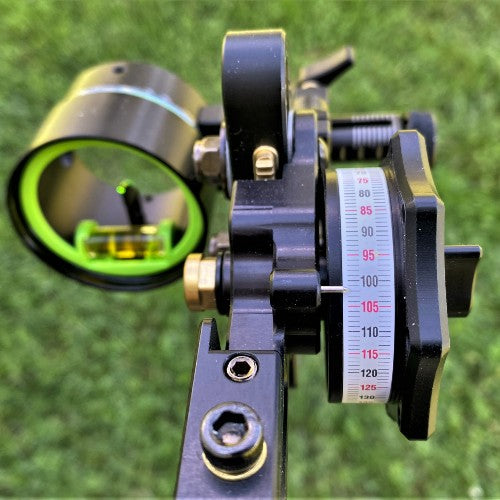Shooting long distance with a compound bow has never been more popular than it is right now. Whether it’s hunting or shooting targets, compound archers are shooting farther than ever.
Depending on your setup, the maximum distance you are able to shoot with an exact aiming reference might only be 80 yards or so. Ever wonder how those other archers are able to accurately shoot 100 yards and farther? That is, how are they able to set their sights that far, when your arrow would hit your sight if you dialed it beyond 80 yards?

We’ve got some tips for you.
First, if you want to shoot from 20-100-plus yards, you’re going to need a movable sight, whether you shoot a single-pin sight or multi-pin. There’s no way you can have aiming references for 20 yards and 100 yards without moving your scope housing. So get a sight that allows you to freely adjust the scope housing up and down.
Once you have a sight that is capable of adjusting from 20-100 yards, here are the primary factors that can extend your range:
Increase draw weight
The heavier your draw weight, the faster your arrows will fly. And the faster they fly, the flatter their trajectory, which extends your range.
Decrease arrow weight
Lighter arrows have a flatter trajectory than heavy ones. Shoot a lighter arrow than you currently have and the trajectory will flatten, which will extend your range.
Now this option assumes you aren’t already shooting an ultralight arrow, which would be in the neighborhood of 5 grains per pound of draw weight. So for a bow with a 70-pound draw weight, this would be a 350-grain arrow. That’s already super light, and going lighter will accomplish nothing.
But if you’re shooting a typical hunting arrow weighing 425-450 grains or so, then cutting arrow weight will help boost arrow speed, which will extend your range.
Raise peep height
Moving your peep higher than it currently sits adjusts how you look through your scope housing. It elevates your perspective, which means you’ll have to move your scope up to keep your aiming references on target. When you move your scope up, you extend your range.

Be aware, this will change your anchor point. Archers often shift to what they call a “floating anchor” when they shoot at the farthest distances possible for their setups. A floating anchor in this situation is a lower anchor. Your head has to move up to look down through the peep to center the scope at its farthest setting, but your release hand can’t move up from the D loop. It stays in a fixed position, which means you have to anchor lower than normal.
We’re not talking about moving your peep a lot here. Start with an eighth of an inch and see how much distance that gains you and go from there. Ideally, you want to find the peep height that gives you the greatest range of distances from close to far, with minimal anchor adjustment.
Move your scope in toward the riser
Obviously, this tactic requires you to have a sight with a bar that can slide in and out from the riser. As you move the scope closer to the riser, you again change your perspective through the peep, which requires you to raise the aiming reference to stay on target at a given distance. And when you raise the aiming reference, you extend your maximum range.
Use your level as an aiming reference
Nothing sits lower in your scope than your level. Learn to use the top of it to aim at long-distance targets. When your bubble is sitting in the middle, it sort of acts like a pin that you can center on your target. This is nowhere near as precise an aiming reference as a pin or a dot, but it is something you can use to aim, and it will extend your maximum range.

